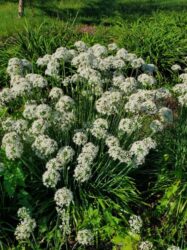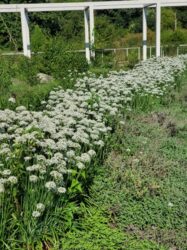By volunteer
 Garlic chives (Allium tuberosum), also known as Oriental garlic, Asian chives, Chinese chives and Chinese leek, originated in the Siberian-Mongolian-North Chinese grassland plains. Widely grown around the world, it can used as an ornamental or edible plant. It has been used in Chinese herbal medicine for a variety of ailments.
Garlic chives (Allium tuberosum), also known as Oriental garlic, Asian chives, Chinese chives and Chinese leek, originated in the Siberian-Mongolian-North Chinese grassland plains. Widely grown around the world, it can used as an ornamental or edible plant. It has been used in Chinese herbal medicine for a variety of ailments.
Allium tuberosum is a rhizomatous, clump-forming perennial plant growing from a small bulb. In Asia its primary use is culinary, whereas in North America ornamental use dominates.
Seeds can be started indoors 6 to 8 weeks before the last frost date. They should be sown thickly and then thinned to 3 to 4 seedlings before planting outside 4 to 6 inches apart when soil temperatures reach between 60 and 70°F. If direct sowing is preferred, put seeds ¼ inch deep after the last frost date.
For a quicker harvest, plant clumps can be divided into smaller clumps and replanted with fresh compost. The oldest roots in the center of the plant should be discarded.
Although garlic chives like full sun, they grow well in partially shaded areas. They like well-drained fertile soil with an optimum pH of 6.2-7.0. Compost-rich soil typically proves enough nutrients.
 Like their onion-flavored relatives, garlic chives are easy to grow and require minimal upkeep. The plants need plenty of water, about 1 inch per week. Mulching, using straw or leaf mulch, is advantageous as it conserves moisture and minimizes weed growth.
Like their onion-flavored relatives, garlic chives are easy to grow and require minimal upkeep. The plants need plenty of water, about 1 inch per week. Mulching, using straw or leaf mulch, is advantageous as it conserves moisture and minimizes weed growth.
Once the plant is established, individual stalks can be harvested as needed but only one third of the plant should be removed at a time. New growth can be promoted by cutting off the plant at the base of the leaves, right above soil level. Garlic chives bloom in the fall giving beautiful white flowers which can be pruned if you want to keep the plant from self-seeding and to check growth. To maintain optimal growth vigor, clumps should be divided every 3 to 4 years in the spring or fall.
Garlic chives make excellent garden companions to celery, mint, lettuce, tomatoes, carrots, cabbage, rose, apple, grape and strawberries as garden pests are thought to be repelled by the plants aroma. However, avoid growing Garlic chives next to peas and beans.
 The flowers are attractive to pollinators. It is not unusual to see flower heads with several bees either sleeping or resting and enjoying the sweet scent.
The flowers are attractive to pollinators. It is not unusual to see flower heads with several bees either sleeping or resting and enjoying the sweet scent.
Although the leaves of Allium tuberosum have a mild garlic flavor, the bulbs are strong and sharp when eaten raw. For culinary purposes, the leaves are used a similar way as chives or green onions. They can be added to salads, egg dishes, soups, stews and stir fries. Preservation, by dehydration or freezing, allows use during the winter. The flowers are also edible; to garnish or added to salads.
The Roman satirist Martial wrote “He who has chives on his breath is safe from being kissed to death”.

-Volunteers, Tony Jevans and Cliff Keller

